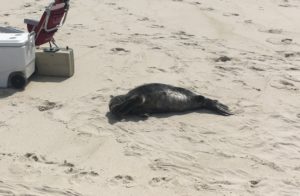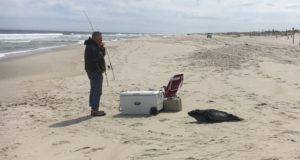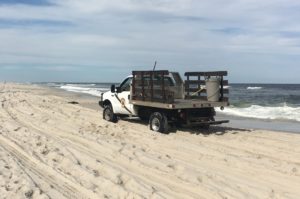Hello Fellow Readers, Thanks to those that reached back about last week’s chat – Let Fawns & Wildlife Be. It’s a delight to hear how many of us relish the beauty of young life unfolding. Interactions with wildlife can undoubtedly bring tears to our eyes at the wonder of it all, bringing to mind when we ran into a seal pup surprise. I hope you enjoy the story.
In April 2017, while walking along Island Beach State Park, NJ, with canine kid Ellie, we spied a fisherman with what looked like a dog. I should preface that dear Miss Ellie suffered from anxiety and fear of other canine kids. As we began to walk around the fisherman, he pointed to his pup. To our surprise, it was a seal pup, and Ellie was not fearful but curious, as were we.

Playful Seal Pup is blowing his nose…
Seals are known as Sea Dogs.
Seals, or pinnipeds meaning “fin-footed,” are commonly called sea dogs, and after meeting this little fellow, it’s clear why. He looked like a playful puppy showing off by arching his back and flipping around to watch a truck as it passed by. The pup squeezed his nose with his fin in a playful moment, or maybe he was clearing his ears from being deep at sea.
“The little guy doesn’t move too fast,” the fisherman said, who was minding his tackle when the little guy crawled next to him.
I suspect our finned friend was a harbor seal pup with silvery-grey fur that glistened in the sun. They range from grey to brownish black or black and often sport spots. Males grow to five feet and 250 pounds. Females are 150 to 200 pounds. Harbor seals can swim as soon as they are born and depend on their mother’s milk for three to six months, then head out on their own to live up to 25 years.
Why the Seal Pup may have trusted the Fisherman
Technically we were standing too close, though the seal chose to park himself accordingly. It would be best if you stayed at least fifty yards away. Seals can be dangerous when approached; their bite is more severe than a pit bull. Mary worrywart wondered if the pup was injured or lost, though he looked well nourished.
They usually hunker down in small groups called colonies in haul-out sites where they rest, warm themselves and escape predators like sharks and people. Later I learned the Marine Mammal Stranding Center in Brigantine, NJ, had recently released five baby seals that likely came from colonies in Massachusetts and Maine they nursed back to health. I wonder if the fisherman’s pup was one of them, explaining his trust in humans.
Seal Pup Security
While checking on the pup that afternoon, the fisherman was gone; replaced by a New Jersey State Park official sitting vigil in a truck equipped with a bull horn which I coined as Seal Security.
“Stay away from the seal, stay away from the seal,” Seal Security announced to horse riders passing by.
Sound asleep; he looked like driftwood that washed ashore. We chatted with the official, who said he was there to keep people away.
“The seal knows what he’s doing. He’s here to warm up.”
Seals swim south to feed on fish heading north after winter. Keep your distance if you encounter fawn or other babies in your garden. Don’t interfere. Instead, marvel over the miracles of Mother Nature. She knows what she is doing.
Garden Dilemmas? AskMaryStone@gmail.com and your favorite Podcast App.
This story and an announcement about Growing Forward are featured in the Garden Dilemmas Podcast: Here’s a direct link: https://www.buzzsprout.com/607129/13008783.





Loved this post! Amazing pictures and story. Mother Nature knows what she’s doing.
Thank you! She sure does :^)